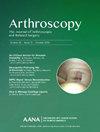Anatomic Risk Factors for Lateral Patellar Instability
IF 4.4
1区 医学
Q1 ORTHOPEDICS
Arthroscopy-The Journal of Arthroscopic and Related Surgery
Pub Date : 2024-10-28
DOI:10.1016/j.arthro.2024.08.009
引用次数: 0
Abstract
With an incidence of approximately 42 per 100,000 persons annually, patellar instability is a debilitating condition that can result in dysfunction of the normal patellar tracking and potential cartilage damage. The stability of the patellofemoral (PF) joint involves an intricate relationship between muscular forces, soft tissues, trochlear and patellar geometry, and limb alignment. Several anatomic patellar risk factors (APRFs) have been identified including patella alta (Caton Deschamps >1.2; Insall-Salvati >1.2), rotational malalignment (femoral anteversion >30°, knee rotation >10°, and tibial rotation >35°), genu valgum (Valgus: zone 2 or greater), a lateralized tibial tubercle (tibial tubercle-trochlear grove distance >17 mm; tibial tubercle-posterior cruciate ligament distance >21 mm), and trochlear dysplasia. The importance of APRFs is highlighted by their overwhelming association with patellar instability; >80% of patients with patellar instability have at least 1 risk factor. Biomechanically, these risk factors increase lateralizing forces on the patella, increase maltracking (patellar tilt and subluxation), decrease contact area, and increase pressure in the PF joint. In addition, there is greater anisometry of the medial PF ligament reconstruction. Clinically, the presence of APRFs increases the chances of recurrence after a first episode as well as failure rates of medial PF ligament reconstruction. Initially described by Dejour on lateral radiographs, current APRF evaluation includes standard radiographs along with axial slice imaging, with magnetic resonance imaging being more commonly used currently. In some instances, mechanical axis radiographic views and axial computed tomography rotational alignment studies may be indicated. Each risk factor can be assessed independently, as there are good-quality studies defining abnormal thresholds for individual APRF. However, there is a lack of robust clinical data defining use of these thresholds for guiding decisions regarding nonsurgical/surgical treatment, specifically, which factors need to be surgically managed and at what threshold for optimal outcomes. It is important to understand that there is an intricate and complex interaction between risk factors that need to be considered during PF evaluation. Overall, evaluation of APRF is one of the core elements of PF instability management.
髌外侧不稳的解剖风险因素
髌骨不稳每年的发病率约为十万分之四十二,是一种使人衰弱的疾病,可导致正常的髌骨跟踪功能障碍和潜在的软骨损伤。髌骨股关节(PF)的稳定性涉及肌肉力量、软组织、髌骨和髌骨几何形状以及肢体排列之间错综复杂的关系。目前已发现几种髌骨解剖风险因素(APRFs),包括髌骨内翻(Caton Deschamps >1.2; Insall-Salvati >1.2)、旋转错位(股骨内翻 30°、膝关节旋转 10°、胫骨旋转 35°)、膝外翻(外翻:2 区或更大)、胫骨结节外侧化(胫骨结节-胫骨沟距离 17 毫米;胫骨结节-后交叉韧带距离 21 毫米)以及胫骨髁发育不良。80%的髌骨不稳患者至少有一个风险因素,这凸显了APRF的重要性。从生物力学角度来看,这些风险因素会增加髌骨的侧向力,增加髌骨的错位(髌骨倾斜和半脱位),减少接触面积,增加 PF 关节的压力。此外,PF 内侧韧带重建的异常程度更大。在临床上,APRF 的存在增加了首次发作后复发的几率,也增加了 PF 内侧韧带重建的失败率。APRF 最初由 Dejour 在侧位X光片上描述,目前的 APRF 评估包括标准X光片和轴向切片成像,磁共振成像是目前更常用的方法。在某些情况下,可能需要进行机械轴放射影像和轴向计算机断层扫描旋转排列研究。每个风险因素都可以独立评估,因为有高质量的研究定义了单个 APRF 的异常阈值。然而,目前还缺乏可靠的临床数据来确定这些阈值是否可用于指导非手术/手术治疗决策,特别是哪些因素需要手术治疗,以及达到什么阈值才能获得最佳治疗效果。重要的是要明白,在 PF 评估过程中需要考虑风险因素之间错综复杂的相互作用。总之,APRF 评估是 PF 不稳定性管理的核心要素之一。
本文章由计算机程序翻译,如有差异,请以英文原文为准。
求助全文
约1分钟内获得全文
求助全文
来源期刊
CiteScore
9.30
自引率
17.00%
发文量
555
审稿时长
58 days
期刊介绍:
Nowhere is minimally invasive surgery explained better than in Arthroscopy, the leading peer-reviewed journal in the field. Every issue enables you to put into perspective the usefulness of the various emerging arthroscopic techniques. The advantages and disadvantages of these methods -- along with their applications in various situations -- are discussed in relation to their efficiency, efficacy and cost benefit. As a special incentive, paid subscribers also receive access to the journal expanded website.

 求助内容:
求助内容: 应助结果提醒方式:
应助结果提醒方式:


